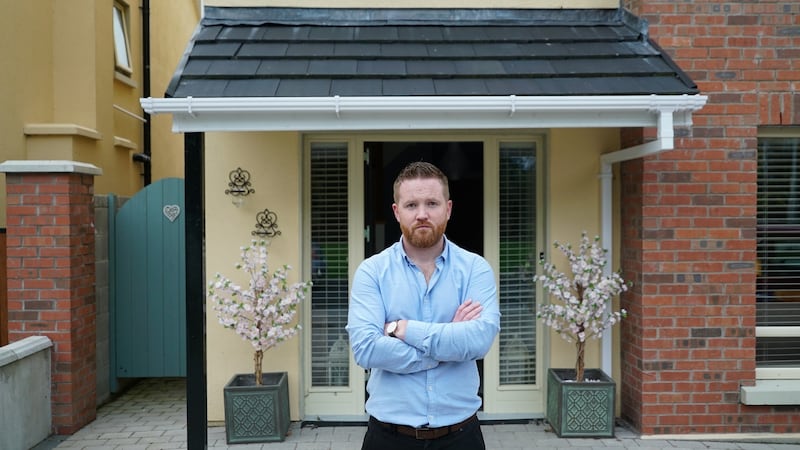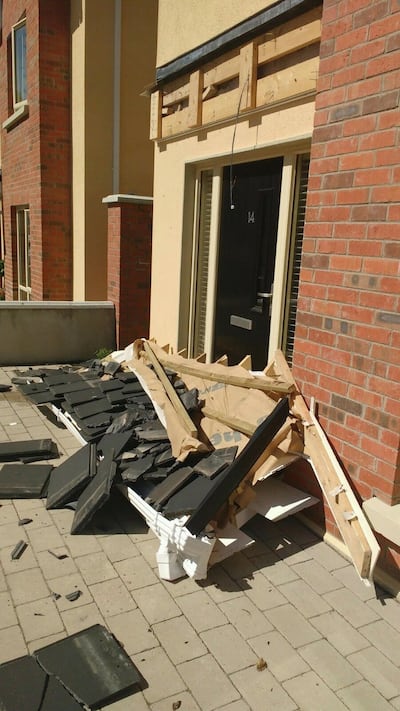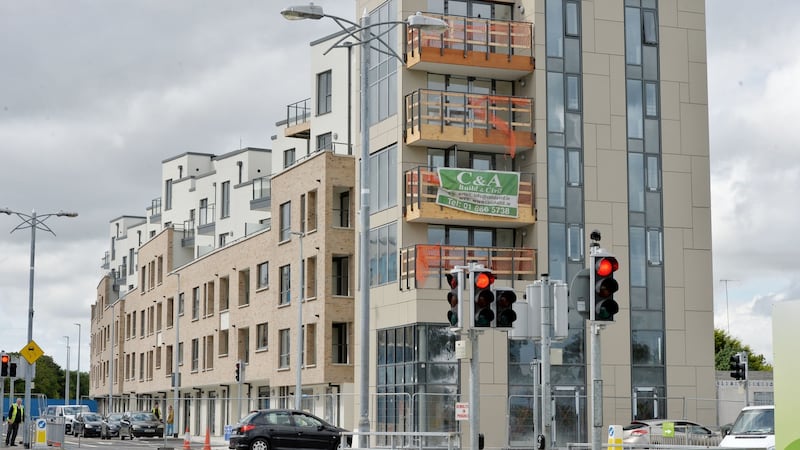John Gormley and his wife had been living in their newly built Kildare home for just over a year when parts of it came crashing down around them. “It was a Sunday morning and my wife was heading off to work, around 10am, I gave her a kiss at the door and waved her off,” says Gormley (not to be confused with the former Green Party leader of the same name).
“I had barely sat down and wallop – a big shudder in the house. I opened the door and the canopy was right at the door, it just dropped.”
The houses at Oak Grove, in Derrinturn, Co Kildare, were built in 2017 by Town and Country Builders Ltd, a company managed by Alan Byrne.

Photographs taken just after the incident, which happened in June 2018, show the large canopy structure laying shattered on the driveway.
Original architectural drawings from John Cross Architects show two pillars were due to be built to support the roof canopy above the door of each of the houses in Oak Grove. No supporting pillars were built in any of the houses, and in the case of Gormley’s house, the canopy was tacked on to the outside wall with nails – no other supports were in place.
New building regulations, introduced in 2014 in the wake of Priory Hall, require on-site inspections by an assigned certifier – paid for by the developer – as part of a formal inspection plan.
In 2017 Oak Grove was certified by John Cross Architects as being compliant with those regulations. In 2018, after the canopy incident, an engineer’s report stated: “It is obvious that the canopy roof was not built to the standards required or as per the construction drawings.”
“The collapse of the canopy roof could have caused fatal damage,” the report, compiled by Declan Kearns, states.
The presence of a defect – even a potentially fatal one – does not necessarily mean that building regulations have been breached. And some structural defects may not be apparent to the person charged with certifying the building.
Defective building has blighted the industry since the start of the Celtic Tiger. During Ireland’s building boom, between 1997 and 2007, a total of 685,988 houses and apartments were built, according to ESB connections data.
We've contacted them umpteen times, we've begged, called, cried down the phone to them but we've got nothing
There are no figures on how many of those new builds contain defects, though there are indications as to the extent of the problem. In October 2015 Nama told the Dáil’s Public Accounts Committee that there were fire hazards in 150 of the 300 vacant properties under the agency’s control and that it has already spent €100 million fixing structural defects.
In March 2019 property management company KPM told The Irish Times it had found significant fire safety issues in “almost all” of the 60 apartment developments it manages.
And speaking to The Irish Times this year, Noel Larkin, a member of the Society of Chartered Surveyors Ireland (SCSI), said building defects such as lack of fire stopping were “present in most apartment buildings” built during the boom.
The SCSI made a submission to the Department of Housing in 2017 calling for a high-level study of Celtic Tiger-era apartments in order to quantify the extent of building defects, but that has yet to materialise.
A major factor in the preponderance of building defects during the Celtic Tiger period was slack regulation. Fire safety certificates were (and still are) granted by the local authority based on plans submitted before the development is built. There was no required follow-up to ensure the complex was built to the standard that was promised in the plans.
In practice, this meant few inspections were carried out, making the system heavily reliant on self-certification.
The industry was “working at a very high capacity; skillsets were in short supply, and these things got through the net,” Larkin says.
“People say ‘sure we have a fire safety certificate, you must be wrong in what you’re saying’. But what you have to understand is that a fire safety certificate is issued before a building ever goes to site,” Larkin says.
In Celtic Tiger Ireland, with its overworked and under-resourced construction industry, apartment blocks were built quickly – often too quickly.
The most common defect found in the course of a long investigation by The Irish Times has been the lack of fire-stopping measures in apartment blocks. The investigation, which began in December 2018, has uncovered defects in 31 developments comprising almost 2,000 apartments in Ireland.
Fire safety certificates are granted on the basis that an individual apartment, corridor or lift shaft can contain a fire for 60 minutes before spreading, giving residents time to escape.
Insulating materials such as intumescent wraps – which expand when they get hot, to close a gap – should be installed around waste pipes, cables, air ducts or any service that runs through a number of apartments. There should also be emergency lighting, fire doors and fire-stopping between walls to prevent smoke and fire from spreading.
“The reality is that these are the standard deficiencies that are present in most apartment buildings,” Larkin says.
The work required to remedy these issues can cost millions, as the gaps are hard to get at once a building is complete. Kitchens, bathrooms, walls and ceilings must be ripped out, opened up and filled out with fire-stopping material before being put back together again.
At St James’ Wood in Kilmainham, residents were asked to pay up to €17,000 per apartment to cover an overall bill of €1.78 million to fix these kinds of fire safety issues.
The Fire Services Act of 1981, brought in after the Stardust fire at a nightclub in Artane that year, gave the fire brigade strong powers in the event of suspected safety issues. Under this legislation, if an inspector is not happy with a building’s safety they can make an application to the High Court to have it evacuated and made safe.
This is what happened at Priory Hall, the development in Donaghmede, north Dublin that was evacuated in 2011 after it was found to be a very serious fire safety risk with significant structural deficiencies.
The term “defect” can describe a range of problems, from faults deep in the structure of a building such as Priory Hall, which had to be vacated and partially reconstructed, to more easily fixed external problems like the one at Oak Grove.
Under Irish law, homeowners have only six years from the time a defect becomes “manifest” to chase the builder or developer through the courts.
In most cases of missing fire-stopping or defective balconies, it is argued successfully that the damage became manifest the day it was built. This means that for most houses and apartments built during the Celtic Tiger, the time frame in which the builder is liable has run out – often before owners were even aware of the damage.
Lydia Bunni, a barrister who specialises in construction law, says this is “terribly unfair’’.
“You or I are not experts; we could have a crack in our wall that we just think is an innocuous settlement crack, we just leave it. Then it becomes bigger and we discover that actually there’s a huge defect in the structure of the property – but because we didn’t act on it, we’re out of time because it became manifest when that crack first appeared.
“It’s really, really unfair, and it’s never as unfair as in cases like this when construction is involved because people are investing a huge amount of money in these buildings.’’

Even if owners discover the defect within this six-year gap, there is a second hurdle to cross: is the developer still in business?
“There’s just a huge amount of hurdles that homeowners have to face,” Bunni says. She believes a discoverability test, similar to one in existence in the UK, would give some protection to house buyers because the clock would not start ticking until the day you discovered the damage.
“I do think the law needs to change... It would seem to be a fairer solution to homeowners who go in to buy a property. When you go in to buy a house you can’t do any investigation works, you can’t open up the walls to see what’s behind them so you just simply don’t know. That’s through no fault of your own,” Bunni says.
But even if a discoverability test were introduced in Ireland now, such a law would not act retrospectively – meaning those who bought during the boom would still have no legal recourse.
“I don’t think [the law] necessarily set out with an intention to protect them [developers] but ... it’s making it extremely difficult for homeowners to be able to pursue,” Bunni says.
Deirdre Ní Fhloinn, a construction barrister and Green Party councillor, says the lack of legal protections for homebuyers were first noted in 1977 by the Law Reform Commission.
“They identified that there are no insurance requirements, no registration or licensing requirements for anyone who starts to build,” Ní Fhloinn explains.
“That paper recommended bonding and possibly an industry levy. They looked at whether or not developers should have to put a bond in place, and they looked at whether or not a bond for a minimum percentage should be in place for all new housing, and that it would be half paid by the developer, half paid by the Government.
"Then Homebond appears within about 12 months of the publication of that report of that paper," she says. Homebond was established in 1978 under the umbrella of the Construction Industry Federation, to give homeowners "insurance cover in relation to deposits, stage payments and structural defects issues," according to its website.
However, Ní Fhloinn says its protections were not strong enough. “It was like a kind of a membership scheme. It paid out in certain circumstances and it didn’t pay out in others. It wasn’t an insurance policy. It was like a home warranty policy.”None of the homeowners spoken to as part of this investigation was covered by their Homebond warranty.
In 2014, new legislation was passed to address the issue of self-certification. The Building Control (Amendment) Regulations 2014 require on-site inspections by an assigned certifier as part of a formal inspection plan. These checks take place throughout the building process, and create a paper trail for the prospective buyer.
The regulations were designed to protect people such as John Gormley, though clearly they have failed the residents of Oak Grove.
When Kildare County Council was notified of the problem at the Derrinturn estate, a senior engineer from its building control department visited the site and agreed with the developer that Town and Country Ltd would build one pillar as a structural support to all of the canopies in the estate and that this work would be carried out under the supervision of assigned certifier John Cross.
It was agreed that once this was completed, Cross would issue a letter to the council certifying the canopy structures as being structurally safe.
In the months that have passed since this work was carried out, the Oak Grove Residents Association has requested proof of certification from Kildare County Council on numerous occasions, but have yet to receive evidence that the new one-pillar construction is safe.
“If I put the house up for sale today and you came down to view it with your engineer he’s going to ask why is there only one pillar, and I’ll say say oh, well, Kildare County Council agreed with their engineer and architect/draftsman and builder that one pillar would suffice, but we still haven’t got the sign-off,” Gormley says.
“It also affects the future resale value of the house as well as our insurance. We’ve contacted them umpteen times, we’ve begged, called, cried down the phone to them but we’ve got nothing.”
Responding to questions from The Irish Times on this issue, Kildare County Council said “a building can comply with the requirements of the Building Regulations without being in compliance with the granted Planning Permission.
“It is the role of the Assigned Certifier to sign off that the structure is constructed in compliance with the Building Regulations.
“There have been ongoing communications between the Building Control Section and the Builder and Assigned Certifier with a view to remediating the issues to the required standards.”
What needs to happen?
Orla Hegarty, assistant professor of architecture at UCD, says the central flaw with the 2014 regulations is that the assigned certifier is appointed and paid for by the developer and is only required to do the amount of inspection the developer asks for.
“There’s no requirement in law as to how many inspections are carried out; they could do one at the very end or they could do one every week. It depends on the certifier,” Hegarty says.
“If the person doing the inspections is not doing what the developer wants then they can replace them.”
She believes there should be “a standardised NCT for housing that prioritises safety risks and differentiates them from routine maintenance works”.
This would “provide immediate reassurance and allow works to be programmed and budgeted over a number of years,” she says.
Eamonn O'Boyle, a fire safety consultant and former deputy chief fire officer in Dublin Fire Brigade, advocates for something similar. "It's time now for a methodical system of risk assessing buildings across the country. The problem needs to be identified and quantified, and over time the works can be done.
“Hierarchy of risk needs to be identified – that would start with where people sleep, apartments, houses, hotels and hospitals – and then move down the levels of risk consequence, places like office blocks and factories,” O’Boyle says.
Chartered Surveyor and head of Benchmark Property Paul Mooney published a report in June on sustainable apartment living, in which he recommended the establishment of a housing regulatory authority, under the Department of Housing, to ensure owners’ management companies (voluntary groups of homeowners) comply with building regulations and fire safety certificates.
This regulatory authority would also have a tribunal function to adjudicate disputes in owners management companies, as well as an inspection process to ensure compliance with building regulations.
Speaking at the launch, Minister for Housing Eoghan Murphy said he would take the report and "talk to the Minister for Justice, talk to my own people to see what pathway we can find to implement those recommendations that we think are necessary and doing it in a way that is timely".
The department’s response
The department has been slow to come around to any sort of solution over the course of this investigation.
In March a report detailed fire safety and defects at four apartment blocks, including Hyde Square in Kilmainham, where the roof was being held together with push/pull braces.
Responding to questions in the Dáil over that report, Murphy said the Government wanted to find a solution to the problem but “it’s difficult to see one that doesn’t take on this massive open-ended liability on every other taxpayer in the State that the State simply couldn’t meet”.
The department repeated this position in May, after a report on a complex in Dublin 8 where apartment owners were told by a developer to find “compelling” legal advice showing why it should pay the €563,350 bill to address fire safety and balcony defects found there.
Asked about the issue of State support for those facing such bills, a spokesman for the Minister said: “It is not possible for the State to take on responsibility/liability for all legacy issues of defective building materials or workmanship. Nor would it send the right message to the industry regarding their responsibility for compliance.”

Yet Gormley’s story proves the problem of construction defects is no longer a legacy one. The Priory Hall controversy highlighted a widespread problem of Celtic Tiger building defects. The shuttered complex came to represent the broken lives left behind in the wake of the crash.
The 2014 building regulations that followed were designed to protect people like Gormley and their homes, but they failed to do so in this case. As Ireland experiences another phase of growth in the housing construction market, the State must ensure rigorous protections are in place for those embarking on the biggest investment of their lives.
“I was only standing underneath [the canopy] waving my wife off minutes previously,” recalls Gormley. “Imagine if she was there?”
When contacted by The Irish Times in relation to the Oak Grove development, assigned certifier John Cross responded to say he did not wish to comment on the issue. Alan Byrne, of Town and Country Builders, did not respond to requests for comment.
Commenting on the Oak Grove case in particular, the Department of Housing responded to say that under the new 2014 regulations, “it should be clear as to who held the designated roles [of certifier and builder] and who is responsible”.
The Department also advised a number of other routes for the owners involved, including contacting Kildare County Council, “who have powers of inspection and enforcement”, checking their latent defects insurance policy and following a complaints procedure with the Construction Industry Register Ireland.





















